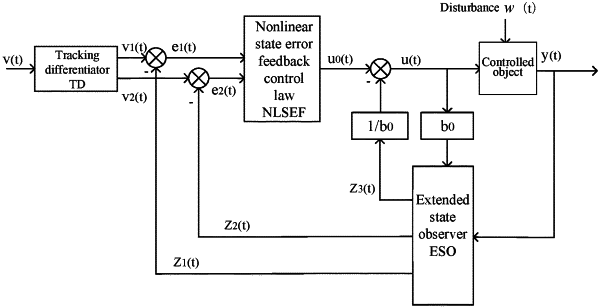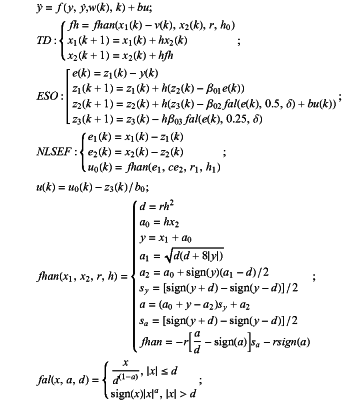| CPC G05D 1/0825 (2013.01) [B64B 1/50 (2013.01); B64B 1/40 (2013.01); B64C 39/022 (2013.01)] | 7 Claims |

|
1. A stability control method based on particle active disturbance rejection, comprising:
establishing an active disturbance rejection controller model according to a dynamic model and a speed loop control model of a tethered balloon system, wherein the speed loop control model is established through theoretical modeling of executive components of a control system of the tethered balloon system; and
optimizing to-be-optimized parameters of the active disturbance rejection controller model using a particle swarm optimization algorithm, and determining an optimal active disturbance rejection controller model;
optimizing, based the optimal active disturbance rejection controller model, an active disturbance rejection controller; and
performing stability control on a photoelectric pod of the tethered balloon system through the active disturbance rejection controller;
wherein the active disturbance rejection controller model is expressed as:
 where ÿ represents a differential equation of a control system of the photoelectric pod; TD represents a tracking differentiator; ESO represents an extended state observer; NLSEF represents a nonlinear state error feedback control law; f(y, y, w(k), k) represents a total disturbance; v(k) represents a system input signal; y represents an output signal; w(k) represents a total external disturbance; differential signals v1(k) and v2(k) are generated by the TD through converting the system input signal v(k); z1(k), z2(k), and z3(k) respectively represent estimators of the differential signals v1(k) and v2(k), and the total disturbance f(y, y, w(t), t); r, h, h0 are parameters of the TD; r represents a fast factor; h represents a system sampling step size; h0 represents a dimensionless parameter, which is an integer multiple of the system sampling step size h; h, β01, β02, β03, δ, b are parameters of the ESO; β01, β02, β03 are coefficient parameters related to the system sampling step size h; δ represents a coefficient, which is taken as an integer multiple of the system sampling step size h; b represents a control quantity coefficient and is a time-varying function, which is a constant b0 approximately; c, r1, h1 are parameters of the NLSEF, where c represents a damping factor, h1 represents a fast factor, and r1 represents a control quantity factor; fhan and fal are expressions of nonlinear functions, respectively; u represents a controlled object; u0(t) represents an error feedback control quantity; a, a0, a1 and a2 are dimensionless intermediate parameters;
wherein the to-be-optimized parameters of the active disturbance rejection controller model comprises β01, β02, β03, c, h1;
wherein the optimizing to-be-optimized parameters of the active disturbance rejection controller model using the particle swarm optimization algorithm, comprises:
step 1, initializing a particle swarm;
step 2, calculating a fitness value of each particle in the particle swarm according to a fitness function, wherein each particle corresponds to a combination of the to-be-optimized parameters;
step 3, updating, according to the fitness value of each particle, an individual extreme value of the particle and a global extreme value;
step 4, updating a position and a speed of each particle;
step 5, determining whether a stop condition is satisfied, outputting an optimal parameter combination, if it is determined that the stop condition is satisfied; returning to and performing the step 2, if it is determined that the stop condition is not satisfied;
wherein the fitness value of each particle is determined according to the following formula:
 where e(t) represents a deviation between a given value inputted into the fitness function and an output corresponding to the given value of the fitness function; Δe(t) represents a difference between two adjacent step outputs of the fitness function; c1 represents a weight of the deviation e(t) in the fitness function, and c2 represents a weight of a square term of the error feedback control quantity in the fitness function; u(t) represents the error feedback control quantity; and Q represents an objective function value;
wherein during the optimizing, a weight factor w is dynamically adjusted according the following formula:
 where Tmax represents a maximum iteration number, wmax and wmin represent a maximum inertia weight and a minimum inertia weight respectively, and t represents a current iteration number.
|